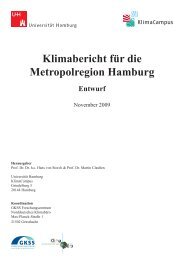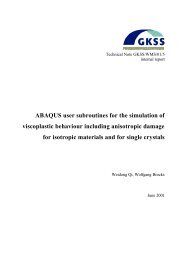Dynamics and Vulnerability of Delta Systems - loicz
Dynamics and Vulnerability of Delta Systems - loicz
Dynamics and Vulnerability of Delta Systems - loicz
You also want an ePaper? Increase the reach of your titles
YUMPU automatically turns print PDFs into web optimized ePapers that Google loves.
asin by switching <strong>and</strong>/or inundation. Many deltas are so populated nowadays that l<strong>and</strong>ward<br />
migration <strong>of</strong> coastal wetl<strong>and</strong> zones is not possible anymore. The deltaic fringe (i.e., subaerial <strong>and</strong><br />
subaqueous parts <strong>of</strong> the deltaic coast interacting with <strong>and</strong> being modified by waves, tides, <strong>and</strong><br />
currents) responds by barrier <strong>and</strong> dune buildup <strong>and</strong> sediment redistribution. Negative feedbacks<br />
or engineering efforts may delay but are unlikely to prevent the destruction <strong>of</strong> deltas.<br />
In this report, we argue <strong>and</strong> demonstrate that given current trends (shifts in climate, upstream<br />
changes in water quantity <strong>and</strong> quality, population pressure), many deltas are in danger <strong>of</strong> collapse<br />
within the 21 st Century. Future preservation <strong>of</strong> deltas will become increasingly difficult <strong>and</strong> costly.<br />
Restoration or maintenance will require developing integrated management strategies that<br />
incorporate extensive monitoring <strong>and</strong> complex numerical modeling as well as detailed consultation<br />
with people affecting <strong>and</strong> affected by deltas.<br />
This report provides a preliminary assessment <strong>of</strong> the impacts to coastal ecosystems <strong>of</strong> environmental<br />
change, associated with climate change <strong>and</strong> with human activities in coastal watersheds,<br />
<strong>and</strong> the response <strong>of</strong> coastal <strong>and</strong> shelf ecosystems to these changes. The report <strong>of</strong>fers an Implementation<br />
Plan for a joint assessment <strong>and</strong> synthesis research project on the vulnerability <strong>of</strong><br />
deltas, based on input from representatives <strong>of</strong> earth system scientists, engineers, physical<br />
scientists, ecologists, economists, geographers, <strong>and</strong> demographers.<br />
This assessment was commissioned jointly by: 1) LOICZ, a joint IGBP / IHDP core project<br />
entitled L<strong>and</strong>-Ocean Interactions in the Coastal Zone (http://www.<strong>loicz</strong>.org), 2) GWSP, a<br />
project <strong>of</strong> the Earth System Science Partnership (DIVERSITAS, IGBP, IHDP <strong>and</strong> WCRP)<br />
entitled Global Water <strong>Systems</strong> Project (http://www.gwsp.org), <strong>and</strong> 3) CSDMS, the National<br />
Science Foundation effort entitled Community Surface <strong>Dynamics</strong> Modeling System<br />
(http://csdms.colorado.edu).<br />
2 Change in <strong>and</strong> <strong>Vulnerability</strong> <strong>of</strong> <strong>Delta</strong>s<br />
Modern deltas developed during the Holocene, during dynamic, but relatively gradual changes in<br />
relative sea level, freshwater <strong>and</strong> sediment input regimes, <strong>and</strong> other environmental characteristics.<br />
Human modification <strong>of</strong> this dynamic balance begins with far-field upstream measures causing<br />
changes in freshwater <strong>and</strong> sediment fluxes downstream. Fluxes are observed to change in both<br />
directions; damming <strong>and</strong> irrigation strongly reduces sediment delivery, whereas deforestation <strong>and</strong><br />
other l<strong>and</strong>-use changes can increase upstream erosion <strong>and</strong> thus sediment delivery to deltas.<br />
The habitat <strong>of</strong> modern deltas appears as a contradiction, sensitive <strong>and</strong> dynamic in nature, yet host<br />
to hundreds <strong>of</strong> millions <strong>of</strong> people. Occupation is made possible by embanking <strong>of</strong> distributary<br />
channels <strong>and</strong> building coastal flood protection. This is <strong>of</strong>ten accompanied by groundwater <strong>and</strong><br />
petroleum extraction, which promotes accelerated subsidence. As a consequence <strong>of</strong> direct human<br />
occupation <strong>and</strong> infrastructure development, natural delta dynamics are reduced, as is the area <strong>of</strong><br />
wetl<strong>and</strong> areas.<br />
The global ocean volume is now rising at �1.8 to 3 mm/y (Bind<strong>of</strong>f et al. 2007), making the<br />
protective coastal wetl<strong>and</strong>s vulnerable to storm surge <strong>and</strong> wave erosion. Predicted climate change<br />
is expected to affect the frequency <strong>of</strong> extreme events such as fluvial floods <strong>and</strong> coastal storms,<br />
including the destructive nature <strong>of</strong> hurricanes.<br />
11





